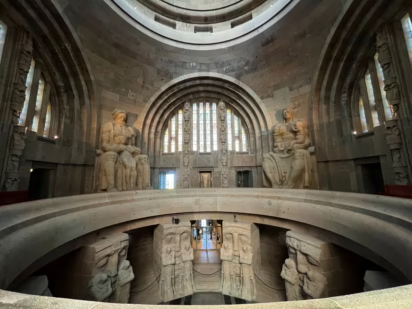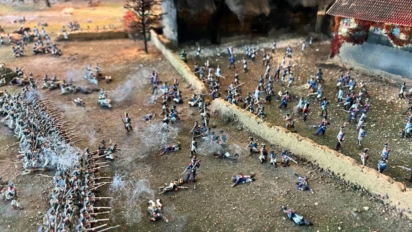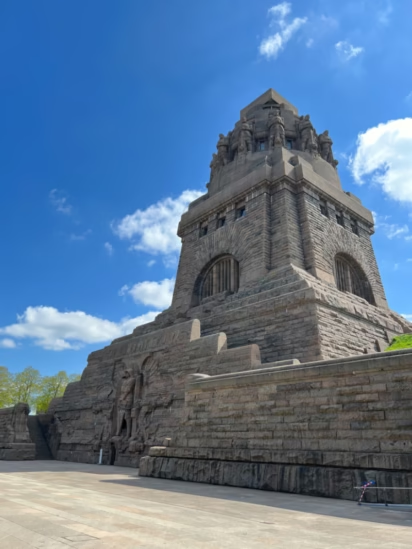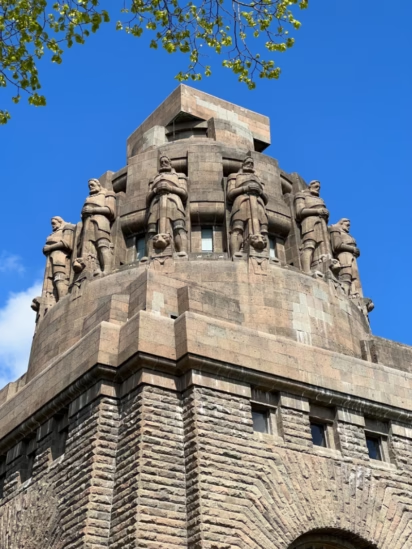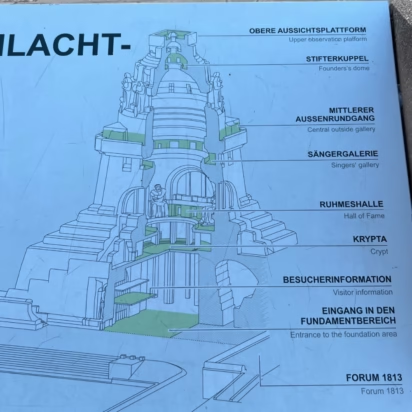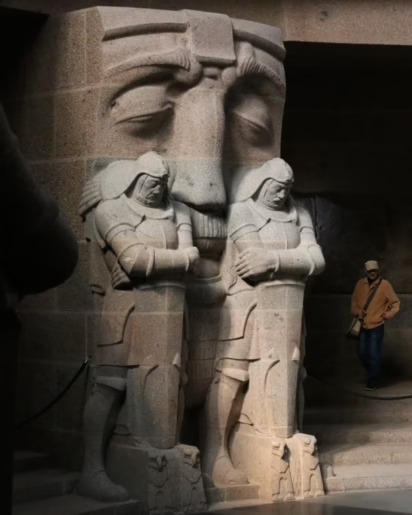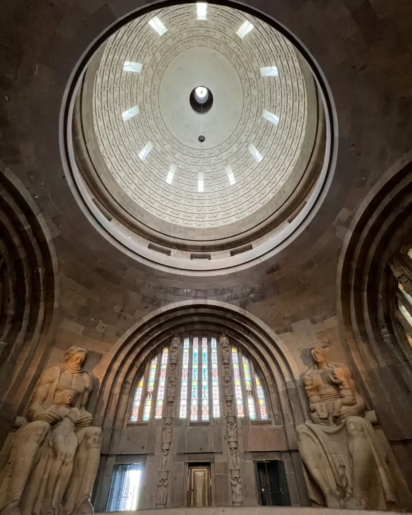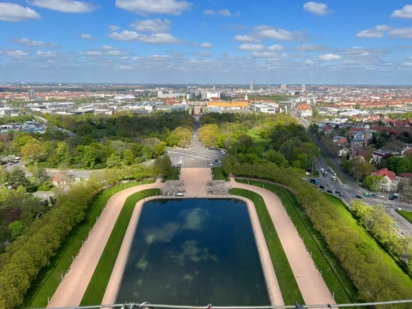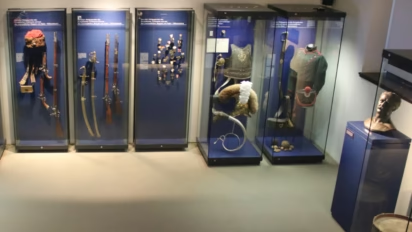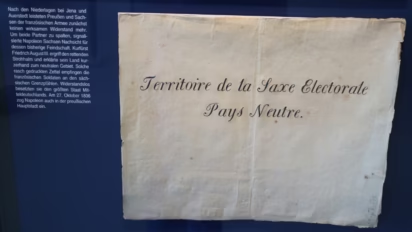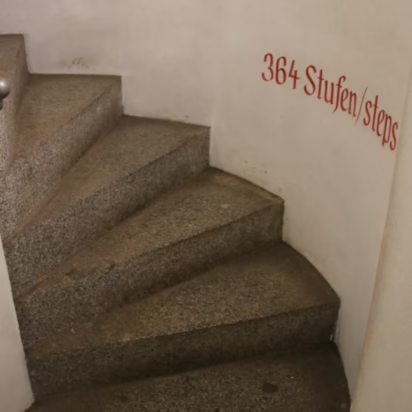Visit the enormous Monument to the Battle of the Nations memorial (Völkerschlachtdenkmal) and Forum 1813 museum commemorating the centenary of the defeat of Napoleon in Leipzig in 1813.

The Battle of the Nations Memorial (Völkerschlachtdenkmal) on the outskirts of Leipzig in Saxony, Germany, is the largest monument in Europe. It opened in 1913 on the one-hundredth anniversary of the largest battle in European history and just a year before the fighting and death toll would be surpassed by the horrors of the First World War. It is interesting to visit this large monument, which is mostly empty but for the permanent sculptures and decorations, and the small Forum 1813 museum with information on the Battle of Leipzig and its history. It is over 500 steps from the bottom to the viewing platform on the top but an elevator also gives access to most of the monument for visitors unable to cope with so many stairs.
Battle of the Nations in Leipzig, 1813
The Monument to the Battle of the Nations was erected as a memorial to the around 100,000 soldiers who died in the largest single battle in Europe prior to the 20th century. At this location to the southeast of Leipzig, Napoleon, assisted by some German states including Saxony, was defeated by an alliance led by Austria, Russia, Sweden, and Prussia.
Over 500,000 soldiers participated in the battle — the death toll in the immediate battle or soon after is estimated at between 90,000 and 120,000 with many more seriously wounded or maimed for life.
The Battle of Leipzig lasted from 16 to 19 October 1813 with the main fighting on the 18th. A defeated Napoleon had to flee to France and was out of power and banned to Elba by May 1814. His final defeat at Waterloo on 18 July 1815 is more famous, especially in the English-speaking world. However, the Battle of Leipzig had more than double the number of combatants and deaths.
The Battle of Leipzig is usually referred to in German as the Völkerschlacht bei Leipzig (Battle of the Nations at Leipzig).
Monument to the Battle of the Nations in Leipzig
Soon after the defeat of Napoleon, initiatives to erect a suitable memorial were launched but as Leipzig was in Saxony, the Kingdom of Saxony long opposed the idea of being reminded that it not only backed the wrong side (at least at the start of the battle) but ultimately lost two-thirds of its territory and half its population (mostly to Prussia) as a result of its miscalculation.
Various plans were proposed and rejected before Bruno Schmitz was entrusted with a monument suitably nationalistic (and bombastic) for the taste of Wilhelmine Germany at the end of the 19th century. (Schmitz previously designed the Kyffhäuserdenkmal in Thuringia and the Deutsche Eck at the confluence of the Rhine and Mosel Rivers in Koblenz). Construction was led by Clemens Thieme, who added the twelve large knight sculptures near the top of the monument and improved the structural engineering aspects of the design.
After a building period of 15 years, Kaiser Wilhelm II inaugurated the memorial on 18 October 1913 in the presence of all the German monarchs (Bundesfürsten). By now, the Prussian-led German defeat of France in 1871 was a stronger national symbol than the battle a century earlier where some of the honor had to be shared with other nations.
The bombastic monument was misused for nationalistic propaganda during the First World War and by right-wing groups during the Weimar era. The National Socialists obviously loved it. The East Germans were going to destroy it but then realized it was a useful reminder of German-Russian cooperation and people’s armies fighting together against a mutual enemy.
Following the latest restoration — early 2000s — it was decided to leave the building mostly empty. Exhibitions are restricted to the history and architecture of the memorial.
Monument Measurements and Construction
Putting aside opinions on the aesthetics, the design was controversial from the start, the monument is quite an impressive architectural and engineering achievement. It remains the tallest memorial built in Europe.
The monument stands 91 m (300 ft) tall with the foundations 70 m (230 ft) by 80 m (260 ft). The interior is 68 m (220 ft) from the crypt to the top of the dome. (The crypt is sometimes used for concerts, with some choral echoes being carried for 10 seconds.)
The entire monument weighs around 300,000 t. Concrete (120,000 m3) is used for 90% of the monument, which is clad with porphyry granite (Beuchaer Granitporphy) from around 26,500 blocks.
Careful planning and an extraordinarily high level of mechanization meant that on average only around 40 people worked on site at any given moment.
The total cost was 6 million mark, which is around €34 million in current financial terms (and about the renovation budget for 2003-2017).
Visiting the Monument to the Battle of the Nations in Leipzig

The Völkerschlachtdenkmal’s interior is mostly empty but for the small exhibition at the information level and large sculptures and decorations that are part of the permanent structure of the memorial. The small museum on the history of the battle is immediately to the right of the monument (separate entrance).
The main western facade is decorated with a large relief of a battle scene. The entrance was traditionally via external staircases decorated with the head of Frederick Barbarossa (1122-1190) — the medieval German emperor who traditionally is asleep but expected to wake up and rescue Germany when in need. (He missed a few opportunities!)
However, visitors now skip the 136 stairs and simply enter via the narrow doors directly below the 20-m tall archangel Michael. St Michael has been considered the heavenly protector of Germany at least since the 10th century and the Battle of the Lech where German nations defeated the Magyars. Above the angel is the Prussian battle motto “Gott mit uns” (God with us).
Interior of the Monument
Visitors enter the monument on the Foundations Area (Fundamentbereich) level. Apart from the impressively large foundations of the heavy memorial, this space is also used on different levels as the information center and for small exhibitions, mostly on the history and the restoration of the monument itself. Since 2006, it has been possible to use an elevator from here up to the crypt.
The Crypt (Krypta) is the symbolic grave of the 90,000 to 120,000 victims of the Battle of the Nations. On each of the eight pillars are huge death masks guarded by a pair of Totenwächter in the form of knights with bowed heads and resting on large shields. The sculptor Franz Metner was inspired by pillars from Thebe in Egypt.
From the crypt, it is possible to look up all the way to the top of the dome, as all the higher levels are rings. The inside of the dome is decorated with 324 Reiterfigure — small from here but visitors going all the way to the top will see them near life-size later on.
The Hall of Fame (Ruhmeshalle) is dominated by four 10-m high sculptures symbolizing the four virtues of the German people that allowed for the victory over Napoleon, according to the turn of the 19th-century opinion. These sculptures are bravery / Tapferkeit (crossed arms), strength of faith / Glaubensstärke (man with child), people’s strength / Volkeskraft (woman with two children), and willingness to sacrifice / Opferbereitshcaft (fist on knee).
The colored glass of the Hall of Fame was recently restored to the original designs. The reliefs on the pillars between the windows are 96 men and women mourning for the dead.
Use the elevator, or the one-way spiral staircases (364 steps) to the Singers’ Gallery (Sängergalerie) at the base of the dome, which has a 29 m (95 ft) diameter. From here, visitors have the best views of the 11 rings of knights on horseback (nearly life-size).
Views from the Monument to the Battle of the Nations


It is only a few stairs, or a very short elevator ride, to the Central Outside Gallery (Mittlerer Aussenrundgang) — the highest level reachable by elevator. From here. it is possible to see some of the large knights (13 m tall and made of 47 granite blocks each) but these are better seen from a distance. Visitors unable or unwilling to take the narrow stairs to the top of the memorial may take comfort from knowing that the views from the top of the monument are hardly better than from this gallery.

An intricate set of stairs takes visitors back into the monument and along the huge knight figures to the top of the dome. Here at the Founder’s Dome (Stifterkuppel) is it possible to look down the central opening but it is hard to see much other than the top of the dome.
More interesting is to take the last flight of stairs — fairly short but narrow and one-way with a traffic light system in force — to the top of the monument and the external Upper Observation Platform (Obere Aussichtsplattform). From here visitors enjoy beautiful views of Leipzig and the surrounding countryside. Visitors will note that Leipzig is not particularly big and that the Saxon countryside is flat but surprisingly green. The most interesting buildings appear to be a centuries-old monastery complex with a church but it actually is the local cemetery with a crematorium and chapel.
It is possible to again stop at all the rings on the way down. Either exit at the bottom or at the Hall of Fame level from where it is possible to use external staircases down as was customary before the completion of the lift from the foundations to the crypt.
The reflection pond was named See der Tränen um die gefallenen Soldaten (Lake of Tears for the Fallen Soldiers) in 1938, so the name is not universally appreciated.
Several green areas, including the park-like cemetery, are in the immediate area. The Napoleonstein, from where Napoleon observed the battle on the 18th, is at the back of the park near the Aral gas station a block from the main entrance of the monument. (Also well marked on most Google Maps.)
Forum 1813 — Battle of Leipzig Museum

Having been misused for political reasons for most of its existence, visitors currently learn absolutely nothing inside the monument about the Battle of the Nations (Völkerschlacht) or the history that led to the war or its aftermath. Fortunately, the Forum 1813 directly next to the monument entrance does a reasonable job.
The museum is fairly small and a bit old-fashioned, which is not necessarily a bad thing. It has trinkets, battle finds, uniforms, maps, and short descriptions common to such museums. The large-scale models of the battle are impressive and enlightening.
Napoleon and his legacy have always been complicated and controversial. For many, including the people he conquered, he brought hope of a better life. Freedom and civic rights gained from his rule could never be permanently removed even after the restoration of previous elites. The museum has several early souvenirs and a few items belonging to Napoleon on display.
As usual, German museums are not shy about black marks in history — especially if two centuries ago. Following the lost battles of Jena and Auerstadt in 1806, Saxony abandoned its Prussian allies and declared neutrality. An interesting display is the white sheets Saxons handed out to arriving French soldiers to confirm the Electorate of Saxony was neutral and not the enemy. Napoleon elevated Saxony to a kingdom and forced it into an alliance. Saxony initially fought on the French side during the Battle of the Nations but Saxon troops changed sides during the battle. After the war, Prussia annexed two-thirds of Saxon territory, or about a third less than it thought appropriate as the price for the betrayal.
Visitor Information: Battle of the Nations Monument (Völkerschlachtdenkmal) in Leipzig

Opening Hours and Tickets for the Völkerschlachtdenkmal in Leipzig
The Battle of the Nations Memorial (Völkerschlachtdenkmal) and Forum 1813 Museum in Leipzig are open daily from 10:00 closing at 16:00 from November to March and 18:00 from April to October.
The monument is only closed on December 24 and 31.
Admission prices including the monument and museum are €10 for adults, €8 for children 6 to 17 years, and free only for children under 6 years old. (Admission to the Forum 1813 only is free for children up to 17.)
Family tickets are €20 for parents or grandparents with their own children or grandchildren. Small discounts are given for the various Leipzig cards and similar tourist passes.
Buy tickets at the information center at the front left of the main monument (past the reflection pool). In the smaller structures at the entrance leading to the reflection pool are toilets and a small restaurant but with the lovely cafes and restaurants of central Leipzig only 15 minutes away, few would regret returning to the center to eat.
Transportation to the Battle of the Nations Monument in Leipzig
Getting to the Monument of the Battle of the Nations Memorial (Völkerschlachtdenkmal) and Forum 1813 Museum, Straße des 18. Oktober 100, 04299 Leipzig, is easy by public transportation, bicycle, or car from central Leipzig. Free parking is available.
The easiest public transportation option from central Leipzig is tram 15 from the Hauptbahnhof (15 minutes), Augustusplatz, and Grassi Museum. Tram stop Völkerschlachtdenkmal is directly before the monument and Südfriedhof directly after (useful if hiking to the back of the memorial). An alternative is any S-Bahn train stopping at S-Bahnhof Leipzig, Völkerschlachtdenkmal, which is a long block (through the park or along Prager Straße) to the monument.
